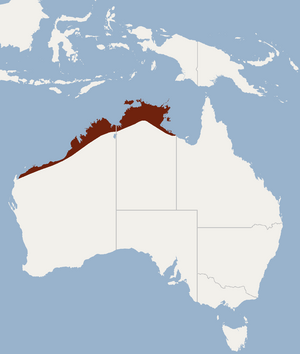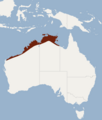Nyctophilus arnhemensis facts for kids
Quick facts for kids Nyctophilus arnhemensis |
|
|---|---|
| Conservation status | |
| Scientific classification | |
| Genus: |
Nyctophilus
|
| Species: |
arnhemensis
|
 |
|
The Nyctophilus arnhemensis, also known as the northern or Arnhem long-eared bat, is a type of bat found in northern Australia. You can find these bats from the northwest part of Queensland all the way to northern Western Australia.
Contents
About This Bat
How It Was Discovered
This bat species was first described in 1959 by a scientist named David H. Johnson. He found the first bat specimen during a science trip in 1948. This trip was supported by groups from both America and Australia.
The very first bat he studied was found near Yirrkala in a place called Arnhem Land. This is why the bat's scientific name, arnhemensis, refers to its origin. The bat is also known by common names like the northern long-eared bat or Arnhem long-eared bat.
What It Looks Like
The northern long-eared bat is a medium-sized bat in the Nyctophilus family. Its lower leg bone (tibia) is about 36 to 40 millimeters long. These bats usually weigh between 5 and 8 grams.
Their fur on their back is a rusty, mid-brown color. The fur on their belly is a bit lighter. They have a small, faint ridge of skin behind their nose. These bats have shorter, wider wings. This helps them fly slowly and carefully through thick trees and plants.
How It Hunts
These bats are skilled hunters. They fly around branches and leaves looking for insects to eat. They are very good at finding food in dense forests.
Where It Lives
Preferred Homes
Nyctophilus arnhemensis bats live in different places like mangrove forests, woodlands, and other forests. They like to rest in thick plants or under loose bark near tree trunks. They especially love to roost under the papery bark of melaleuca trees. They also like to live in pandanus plants near rivers and water.
These bats are common in certain areas, but only where there is good habitat for them. Sometimes, they have even been found living in the roofs of houses! They really like mangrove areas, especially west of the Dampier Peninsula. They also live near freshwater spots like lagoons and waterholes.
Where They Are Found
You can find these bats in tropical parts across northern Australia. They live near fresh or salty water, in coastal areas, and on islands off the coast. Their range stretches from the Kimberley region in the west to the Gulf of Carpentaria in the east. They have even been spotted as far as Cape York.
These bats also live on northern islands like Melville Island, the Bonaparte Archipelago, Groote Eylandt, and the Sir Edward Pellew Group.
Staying Safe
The northern long-eared bat has done well in pandanus environments. They are good at hiding under dead leaves of pandanus plants. They often move to new spots to stay clean or to avoid animals that might try to eat them. The wet areas where pandanus grows give these bats lots of different kinds of food.
Scientists believe that the population of these bats is stable or even growing. Because of this, they are listed as 'least concern' on the international IUCN Red List. This means they are not currently at high risk of disappearing. However, changes to land use, like farming, can affect them. Removing their roosting and feeding areas is the main threat to these bats.
Images for kids
See also
 In Spanish: Nyctophilus arnhemensis para niños
In Spanish: Nyctophilus arnhemensis para niños



